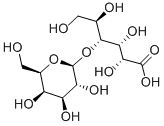| Identification |
| Name: | D-Gluconic acid, 4-O-b-D-galactopyranosyl- |
| CAS: | 96-82-2 |
| EINECS: | 202-538-3 |
| Molecular Formula: | C12H22O12 |
| Molecular Weight: | 358.3 |
| InChI: | InChI=1/C12H22O12/c13-1-3(15)10(7(18)8(19)11(21)22)24-12-9(20)6(17)5(16)4(2-14)23-12/h3-10,12-20H,1-2H2,(H,21,22)/t3-,4-,5+,6+,7-,8-,9-,10-,12+/m1/s1 |
| Molecular Structure: |
 |
| Properties |
| Density: | 1.79g/cm3 |
| Stability: | Stable under normal temperatures and pressures. |
| Alpha: | 22.8 o (C=10, H2O) |
| Water Solubility: | 10 g/100 mL |
| Solubility: | 10 g/100 mL |
| Appearance: | White powder. |
| Specification: |
Lactobionic acid (96-82-2) is white to off-white crystalline powder, also known as UNII-65R938S4DV ; 4-(beta-D-Galactosido)-D-gluconic acid ; 4-O-beta-D-Galactopyranosyl-D-gluconic acid . It is incompatible with strong oxidizing agents. When heated to decomposition, it yields Carbon monoxide , Carbon dioxide . Lactobionic acid (96-82-2) is a sugar acid which can form salts with mineral cations such as calcium, potassium, sodium and zinc. It is also used as an antioxidant in the cosmetics industry and as a salt form in the pharmaceutical industry.
|
| HS Code: | 29400000 |
| Storage Temperature: | Store in a tightly closed container. Store in a cool, dry, well-ventilated area away from incompatible substances. Deep freeze (below -20 C). |
| Usage: | Lactobionic acid is mainly used in preservation solutions for organ transplantation. It is used to produce erythromycine lactobionate. |
| Safety Data |
| |
 |